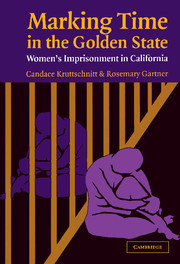Book contents
- Frontmatter
- Contents
- List of Figures and Tables
- Acknowledgments
- Marking Time in the Golden State
- 1 Introduction
- 2 Women, Crime, and Punishment in California
- 3 Entering the Prisons: Methods
- 4 Women's Experiences of Imprisonment at the California Institution for Women in the 1960s and the 1990s
- 5 Variations across Time and Place in Women's Prison Experiences
- 6 Negotiating Prison Life: How Women “Did Time” in the Punitive Era of the 1990s
- 7 Conclusion: The Spectrum of Women Prisoners' Experiences
- Appendix: Characteristics of Interviewees
- References
- Author Index
- Subject Index
7 - Conclusion: The Spectrum of Women Prisoners' Experiences
Published online by Cambridge University Press: 15 December 2009
- Frontmatter
- Contents
- List of Figures and Tables
- Acknowledgments
- Marking Time in the Golden State
- 1 Introduction
- 2 Women, Crime, and Punishment in California
- 3 Entering the Prisons: Methods
- 4 Women's Experiences of Imprisonment at the California Institution for Women in the 1960s and the 1990s
- 5 Variations across Time and Place in Women's Prison Experiences
- 6 Negotiating Prison Life: How Women “Did Time” in the Punitive Era of the 1990s
- 7 Conclusion: The Spectrum of Women Prisoners' Experiences
- Appendix: Characteristics of Interviewees
- References
- Author Index
- Subject Index
Summary
in the fall of 1998, shortly after we completed our field research, Amnesty International singled Valley State Prison for Women (VSPW) out for a visit during its investigation of human rights violations in women's prisons. A year later, thousands of television viewers were introduced to VSPW through American Broadcasting Company's (ABC) six-part Nightline series on women in prison. As part of that series, Ted Koppel interviewed the prison's chief medical officer, Dr. Anthony DiDomenico, who commented that prisoners at VSPW liked having pelvic exams because “it's the only male contact they have.” When DiDomenico was relieved of his duties shortly after the interview, VSPW's fame spread even further as newspapers across the United States and Canada picked up the story. The image conveyed by this publicity was of a massive, overcrowded and underresourced institution where sexual abuse and medical maltreatment of prisoners were commonplace. But while that image might grab public attention and describe some aspects of prison life at VSPW, it simplifies a much more complex picture. The experience of imprisonment at VSPW, the epitome of the neoliberal era prison, also incorporates elements of other penal regimes and political eras. The “intertwining of established and emergent structures” (Garland 2001: 168) of imprisonment can be seen in the continuing abuse and neglect of women prisoners and in the recent and dramatic increase in the numbers of women subject to long periods of carceral control.
- Type
- Chapter
- Information
- Marking Time in the Golden StateWomen's Imprisonment in California, pp. 157 - 162Publisher: Cambridge University PressPrint publication year: 2004



